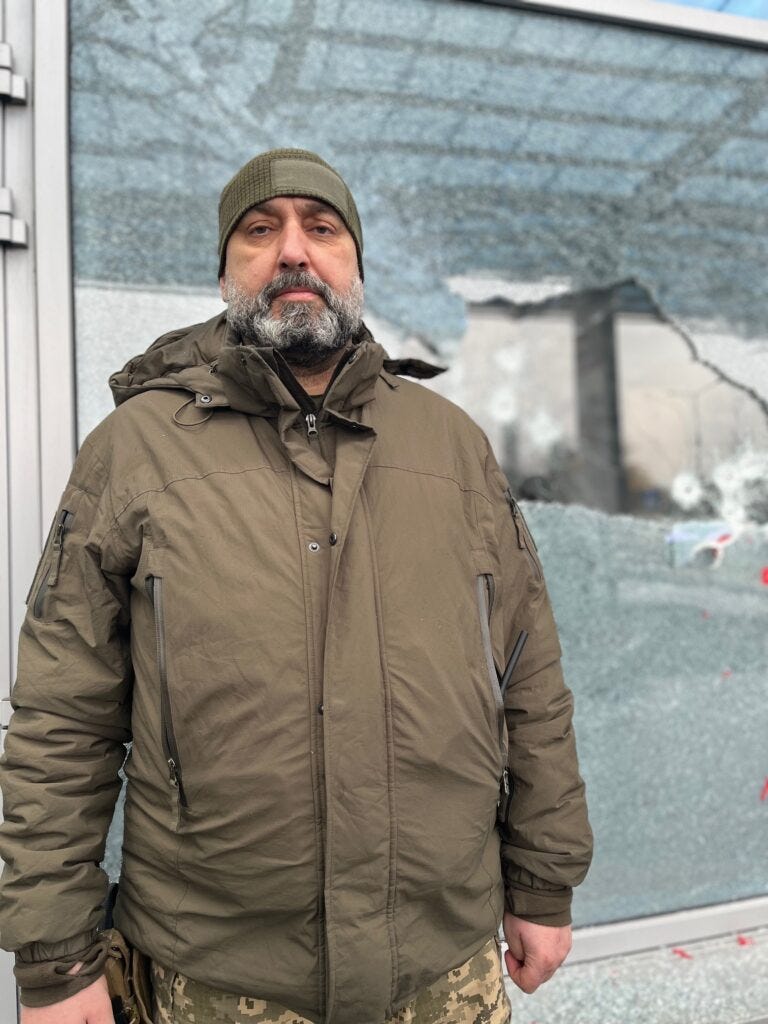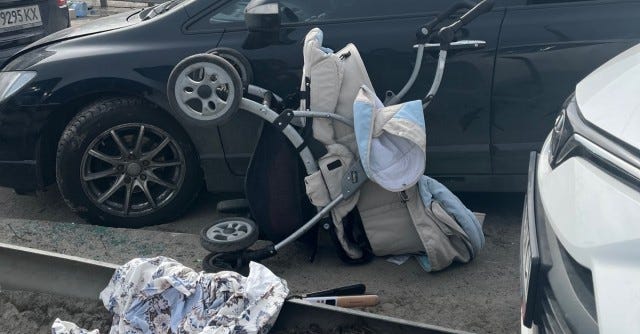DISPATCHES FROM UKRAINE: Mariupol Escape, Nuclear Threats, and Grim Recoveries
DISPATCHES FROM UKRAINE: Mariupol Escape, Nuclear Threats, Grim Recoveries and
“If everyone fought for their own convictions, there would be no war.”
― Leo Tolstoy, War and Peace
ESCAPE FROM MARIUPOL: LEAVING FAMILY, A WOMAN FLEES HER HOMETOWN
Mariya Moskalenko’s last memory of a somewhat ordinary life was Feb. 23, the day before Russia’s full-scale invasion of Ukraine began. Working in Kyiv as a business analyst, she caught a train to her home in the Central District of Mariupol.
“I understood it was a critical situation, but I needed to see my parents and younger brother, and I worried it would be the last time I would see my native town, the place where I was born,” Moskalenko said, tearfully. “I remember what a cool and beautiful day it was, taking a walk with my father by the sea, laughing.”
Just more than two weeks later, Mariupol is now known around the world as a city under siege of the Russian army. Russian bombs struck a children’s hospital on Wednesday, March 9, sending dozens of pregnant women and others carrying infants stumbling into the streets or carried on stretchers. Reports of mass graves are leaking out of the city, and residents live in dark and heatless bunkers as the Russians have closed in.
The morning after Moskalenko arrived back in Mariupol, the city was covered in crusty ice and drab light. A friend called with news: The Russian invasion had begun. Mariupol was an early target. Unlike the battles around Kyiv in Ukraine’s north, Russian forces have advanced steadily in the south, with well-prepared troops and supplies streaming out of Crimea and Donetsk, using well-established trade routes along the Sea of Azov to quickly reach coastal cities like Mariupol.
Mariupol was hit from the land, sea, and skies. Though the war was predicted and planned for and came after weeks of Western intelligence warnings, it still was a massive shock when it erupted.
“I was petrified and in disbelief,” Moskalenko said. “Straightaway, my father went to the gas station because he knew there would be a deficit. I was trying to understand what to do next, trying to support my family and volunteer and bring medicines to the people.”
Two weeks ago, the southeastern Ukrainian port city in Donbas was home to some 430,000. But 13 days of constant pummeling has prompted hundreds of thousands to flee, with an estimated 200,000 trapped inside the rubble and ruins. Over the weekend, Russian forces increased their shooting and shelling as they attempted to surround the fragile city — severing sanitation, electricity, communication towers, and urgent medical supplies. Water supplies were also cut off, leaving scores at risk of dehydration and compelled to drink from the heavily contaminated Kalmius River.
“I was trying to get medicines in for people, but nobody could come to Mariupol,” Moskalenko said. “We had light and water until March 2, and that is when we were shut down totally. We slept in the total darkness, hearing nothing but the shelling above. I could not eat or sleep. I could not believe this was my life, like a nightmare. My body was frozen.”
But the more bombs that rained down, the fewer air raid warnings there were inside the embattled city. Moskalenko thinks it became too constant, too uncontrollable for the government systems to keep up. As the days unfolded, her hometown was plunged into a scene reminiscent of an apocalyptic movie: naked buildings hollowed by relentless bombardment, dead bodies on the street, mangled livelihoods, and terrified children running with their parents to the nearest shelter below ground.
Then, late last week, a missile smashed into a nearby school, killing a 16-year-old boy who was a peer of her younger brother, leaving a crater in the backyard. It was at that moment that she knew home might never be safe again, or at least not for a very long time.
READ MORE ABOUT MARIYA’S ESCAPE
WILL PUTIN DEPLOY NUCLEAR WEAPONS? UKRAINIANS BRACE FOR CHERNOBYL 2.0
General Serhiy Kryvonos stands guard at Kyiv Sikorsky International Airport, moving between glass windows shattered by rockets and his men wedged behind a mounting pile of sandbags.
“We’re ready for anything,” Kryvonos, the former Deputy Secretary of Ukraine’s National Security and Defense Council (NSDC) Army, tells Paradox, his tone measured and his imposing posture upright.
Except perhaps for nuclear weapons.
“Yes, I do think that Putin could use them,” he says without a moment of hesitation. “And you cannot prepare for that. One cannot change their fate.”
In either an act of political agony or humiliation that his military has failed to capture Kyiv at the breakneck speed he anticipated, Vladimir Putin might play the nuclear chess piece. Ukrainians worry it’s not a bluffing tactic either: Days into the war, Putin put his deterrent arms on alert.
Former Russian President Dmitry Medvedev warned last week that the Kremlin could withdraw from the newfangled Strategic Arms Reduction Treaty, initially signed in 2010 and extended last year in an agreement between Biden and Putin to limit the strategic offensive capabilities.
“The only thing that has prevented Putin from pushing that button, or at least moving closer to it, is the U.S. policy of Mutually Assured Destruction (MAD),” one high-ranking Pentagon source, who is not authorized to speak on-record to the media, explains.
Some Ukrainian military experts, however, worry that the full force of a nuclear arsenal is less of a concern than the damage even a partial deployment could do.
Andrii Malakhov, a retired Ukrainian Special Forces soldier turned frontline Commander and volunteer, underscores that the intelligence his team has gleaned from captured Russians is that the “special military operation” would last a maximum of 15 days.
“But Putin will finish this war by then. He has no way and could go nuclear if he thinks there is no other way,” Malakhov tells Paradox. “Nuclear weapons have different degrees of strength. They could drop a small bomb to show off power, destroy a town or a district, and then force negotiations from there.”
Yet, for many Ukrainians, the talk of nuclear weapons is one of bitterness and frustration.
“Please remind Americans that they are co-signers of the Budapest Memorandum,” Kryvonos stresses. “Europe and the West must clearly understand that if they do not support us, they will be the next target. You cannot persuade the Russian bear, you can only kill him.”
CLICK HERE TO READ MORE ABOUT THE NUCLEAR THREAT
GRIM RECOVERY OF THE DEAD BEGINS IN KYIV TOWNS
In a suburb on the fringe of Kyiv city known as Irpin, now defined by a blown-up bridge and ever-increasing Russian shelling and encroachment, those who did not survive the thrashing are being extracted from their homes and carried across the river.
Sometimes the remains arrive all alone, and other times a weeping family member stands guard as the body is loaded on a stretcher; their face covered in soft blankets in one final act to preserve dignity.
“I am very tired, but I get energy from helping people. Before this war, I could not sleep properly; now I sleep like a baby because I am doing something meaningful with my life,” notes volunteer evacuee helper Sergei, 36, who speaks in a gentle sing-song voice. “This is all we can do for them now.”
Throughout an ice-cold Saturday afternoon, I see at least half a dozen of the dead, one man still in his finest suit and shiny shoes. It is not immediately clear how they died.
“Some did not make it through the bombing,” Erik, 30, a recruit to the Territorial Defense Forces, tells me. “And others were very old, all this stress, they died from heartbreak.”
Accurate death tolls have been next to impossible to determine, with many believed to be lying below the rubble and ruins in areas Ukrainians cannot reach. But each day, numbers mount across the country, stretching well into the hundreds.
Much of the search and rescue work to bring the bodies to the crossing point is done by courageous locals themselves, who careen their small cars to and from the dangerous depths of the city to the crossing point. In addition, the injured are often brought to the volunteer medical staff in the back of a bakery delivery bus.
CLICK TO READ MORE ABOUT THE JARRING EVACUATIONS
For those interested in learning more about the aftermath of war, please pick up a copy of my latest book “Only Cry for the Living: Memos from Inside the ISIS Battlefield.”
Also, if you want to support small business:
And also now available Down Under!
Thanks again for your support. Follow me on Instagram and Twitter for more updates.






